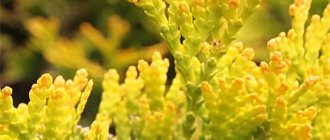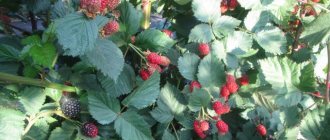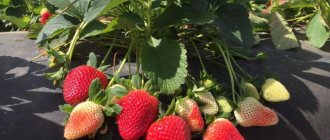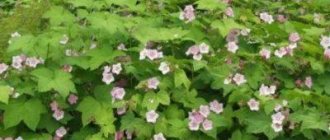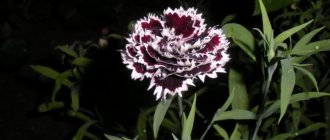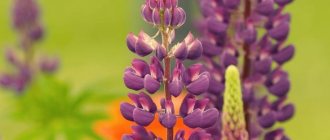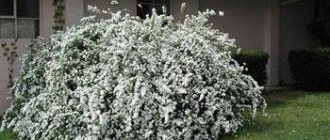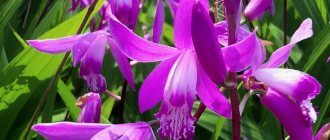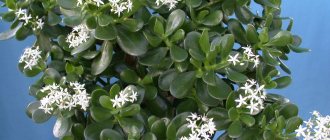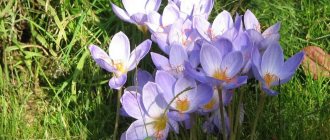| Cherry Morel Bryansk | |
| general characteristics | Vigorous tree up to 2.5 m |
| Ripening period | Second ten days of September |
| Taste | Sweet, with a delicate floral aroma |
| Fruit | 3-5 g |
| Fruiting | up to 10 kg from one tree |
| Winter hardiness | High |
| Pests and diseases | Resistance to diseases and pests is average |
- Morel is a whole group of varieties bred in Europe back in the 18th century . Several varieties are common in our country, and the option we are considering is the most widespread. It is included in the State Register and is successfully grown in all regions.
- Trees are usually medium in size - up to 2.5 meters . With a rounded crown, which must be formed for the proper development and rapid growth of the plant. The foliage is high, the branches are of medium thickness and quite strong. The leaves are dark green, with a smooth glossy surface.
- The berries are large, average weight from 3 to 5 g . The seeds are medium in size and separate well from the pulp. The cherries are almost black; it is from the dark color that the variety gets its name. The main advantage of this option is its excellent transportability, which is why this variety is often used for growing for sale.
- Winter hardiness is good . The cherry tree tolerates midland winters well and does not need additional protection or shelter.
- The variety is not self-fertile; it can bear fruit without a pollinator . But if you plant a pollinator nearby, the plant will delight you with a higher yield, which is 6-10 kg; in unfavorable years, at least 5 kg is collected.
- Cherries have a sweet and sour taste . They are distinguished by dense but juicy pulp and are well suited for any purpose - from fresh consumption to a variety of preparations, juices and even wine.
- The variety is resistant to fungal diseases . It resists well to most diseases and pests, and therefore requires a minimum number of treatments.
It is recommended to bleach a short trunk every spring to prevent diseases and pests
Description and characteristics of the variety
This cherry variety (depending on its variety) can be represented by both shrubs and low trees with spreading crowns. It has the following features:
- Tree. Low - the plant reaches an average height of 1.5 meters, sometimes 2 meters. It has a wide spreading crown with a large number of leaves. The branches of the trunk are ashen-light, the shoots are brownish with a silvery coating. The leaves are medium in size, reaching 7 cm in length. The flowers are small, up to 27 mm in diameter, collected in inflorescences of 4 pieces.
- Fruit. Large (weighing up to 3 grams), thin-skinned, ruby-colored, have elastic, juicy pulp. Their taste is sweet and sour.
The presented species begins to bear fruit from the 3rd year of life. 10-year-old plants have the maximum yield. In the future, the plant's productivity will gradually decrease if rejuvenating pruning of the cherry is not carried out.
Vladimir cherry
You should start by seniority. Vladimir cherry is the oldest dark cherry variety bred in Russia. The history of the Vladimir cherry dates back at least 5 centuries, or even 10. In fact, this is generally the first cherry brought to Rus'. And the monks did it.
They brought seedlings from Greece, and they also adapted the cherry tree to the middle zone. The species has an ordinary multi-stemmed bush, grows from 2.5 to 5 meters in height. The bark is ash-gray, the crown is rounded, with a small number of leaves inside.
The leaves are medium-sized, about 8 cm long and 4 cm wide, dark green in color. 4/5 of the berries are set on annual branches. The fruits can be small or medium-sized, black and red in color. Vladimir cherry belongs to the mid-season cherry varieties. That is, it ripens in mid-July.
The amount of harvest is greatly influenced by the weather during overwintering. In favorable years, you can collect up to 20-25 kg of berries from each bush. Well, if the weather is bad in winter, then you shouldn’t expect a bountiful harvest, a maximum of 5 kg per bush.
Flowering begins in early May. Refers to self-sterile. This means that its pollination requires that cherry trees of other varieties grow nearby. For example, Amorel pink, Griot Moscow, Fertile Michurina, Shubinka pink, Turgenevka, Lotovaya.
These are the best varieties for pollination, but, in principle, there are many more of them. The maturation process is extended and non-simultaneous. Berries harvested at the wrong time quickly fall off.
Despite some capriciousness and dependence on the weather in winter, this variety is widely popular. This is due to good yield, excellent taste and high quality of the fruit. And also because this is a fast-bearing cherry, grafted bushes begin to bear fruit early, 2 years after planting.
Peculiarities
Morel is considered one of the most profitable varieties to grow. Its features include the following:
- Winter hardiness. Morel is a frost-resistant variety.
- Disease resistance. Cherries of this variety are not susceptible to fungal diseases characteristic of fruit crops.
- Pollinators. The variety is considered self-fertile. However, pollination of Morel can also be carried out through its various varieties: Lotovka, Amoreli, Chernokorka. This makes the variety more productive.
- Ripening period and yield. Morel ripens in mid-July. Productivity of the variety: 6-10 kilograms of fruits per tree.
- Transportability. Cherry has a medium shelf life and is well transported over short distances. Some subspecies of Morel (Bryanskaya) tolerate transportation well without losing their presentation.
Morel varieties are resistant not only to diseases, but also to various pests. Thanks to this, gardeners who choose them can reduce the number of preventive treatments of plants per year, using one spraying of trees in the autumn.
Harvesting
Cherries are harvested as soon as they acquire their characteristic burgundy-brown hue.
For this purpose, stepladders or high wooden stairs are used. From old and tall trees, where it is impossible to reach the fruit even with the help of a ladder, the harvest is collected using a long pole with a cup on the upper end. This cup is made from half a plastic bottle.
Important! It will be possible to remove berries from high branches after they are fully ripened, when they begin to fall off the tree on their own.
If you can’t remove the berries using a ladder, you can lay out plastic film under the tree and shake the branches with a long stick.
Varieties
Lotovka berries have a sweet and sour taste; they themselves ripen at the end of July and can remain on the tree for a long time without spoiling. The plant itself is resistant to low temperatures, diseases and pests.
Morel has several varieties popular in gardening. These include:
- Tray. A late variety with burgundy almost black fruits. It is grown for subsequent processing into jam or boiling.
- Chernokorka. This is a multi-stemmed bush with a rounded crown, producing dark, juicy and sweet berries. The Chernokorka harvest can be used both for raw consumption and for making jams, preserves, and wine. The variety is self-sterile; in order for it to bear fruit, another variety of Morel must be planted on the site.
- Morel Bryanskaya. A plant with a wide, rounded crown, produces large dark red fruits with elastic pulp. The fruits of this variety are very transportable, which is why Bryansk Morel is often grown for commercial purposes. The variety is resistant to frost and disease.
- Nephris. This is a medium height tree. Fruiting occurs on bouquet branches, as well as annual branches. The tree produces sweet and sour ruby fruits. Unlike other similar varieties, Nefris is susceptible to fungal diseases and is afraid of frost.
- Amorel Nikiforova. Also called "Amorel Rose". Plants of this variety have a spreading, rounded crown. they grow many leaves and light red fruits with a sour taste.
- Amorel early. This is a vigorous plant with a rounded crown of medium density. Reaches 4 meters in height. Resistant to diseases and pests. It belongs to the dessert varieties, produces large fruits with a sweet and sour taste. Grows well in Astrakhan, Volgograd, Orenburg, Mordovia.
Find out about the best varieties of cherries for the Moscow region at this link.
You can plant several of the above varieties on your site. This will have a beneficial effect on their productivity.
Rossoshanskaya cherry
Bred at the Rossoshansky zonal experimental horticulture station. From which it got its name. The trees are low, reaching 4 m in height. The crown has a pyramidal shape. With age, the branches become very bare. The bark is gray, turning black with age. Leaves up to 10 cm long, up to 5 cm wide.
The fruits are medium-sized, dark cherry, often black, sourish-sweet. Ripening is early and almost simultaneous, occurring already in the 3rd decade of June. The berries can hang on the tree for quite some time. They are also dense and can easily be transported over long distances.
The winter hardiness of Rossoshan cherry is average, that is, the tree can easily withstand frosts down to -35. It begins to bear fruit 3-4 years after planting. But in the first years, fruiting is weak. The peak yield occurs at the age of 6-11 years, usually up to 15 kg per tree.
But in a good year, one tree can produce up to 25 kg of berries. Disadvantages include average yield and poor resistance to diseases such as coccomycosis and moniliosis.
Although the Rososhanskaya black cherry is self-fertile, to increase productivity, it is worth planting pollinator trees nearby. It’s also worth carefully monitoring the soil around the tree, because fallen berries of this variety often germinate and thicken the planting.
Growing
Plants are planted at a distance of 3-4 meters from each other.
Growing Morel on your own plot is not difficult. To do this, you should consider the following features:
- Climatic conditions. The variety is suitable for various climatic zones. However, it is recommended to grow plants in the southwestern and western areas of the garden with good lighting. This will ensure good taste of the fruit.
- The soil. Morel can be planted on any soil, including black soil and sandy soil.
- Landing. For Morel, holes of 45-50 cm are made, the soil is mixed with humus and mineral fertilizers, and 2 kilograms of wood ash are added. The soil is poured into a mound at the bottom of the hole, after which the roots of the seedling are laid on this mound and sprinkled with soil so that the grafting site is several centimeters above the soil. The tree itself is tied to a peg, and an earthen roller is made around the trunk circle so that the water remains in us. After planting, Morel is watered abundantly.
This article will tell you how to plant cherry seedlings.
After planting Morel, the tree trunk circle of the plant must be mulched. This helps prevent excessive evaporation of moisture and cracking of the soil.
Buy only quality seedlings
| Stage 1. Purchase seedlings Find nurseries or farmers in your area who grow seedlings. Avoid purchasing this variety in the markets; they often sell something completely different from what is indicated on the label. Choose one or two year old seedlings . They take root best. The two-year option is also good because its crown is already formed as needed | |
| Stage 2. Select a location and dig a hole The cherry tree should be placed in a well-lit area. The distance to the fence is at least one and a half meters, the distance between trees is 3 meters. Dig a hole about 60 cm deep and 80 cm in diameter . If the groundwater does not lie very deep, then make the hole deeper and add a drainage layer to the bottom | |
| Stage 3. Prepare the hole Pour humus into the bottom of the bucket. Rotted manure or compost will also work. Add 50 g of superphosphates and 20 g of potash fertilizers . You can add 100-200 g of wood ash. Sprinkle 200 g of dolomite flour if the soil is acidic . Pour a small layer of soil on top to place the root part on it | |
| Stage 4. Plant a tree Place the seedling in the middle of the hole. Level it vertically and fill the hole about halfway. Compact well and fill to the top. Make sure that the root collar is above the ground level . You can leave a small depression, or you can add a small bump around the perimeter. Water the seedling . Use 2 buckets of water for each tree. | |
| Stage 5. Mulch the tree trunk circle After watering, loosen the soil well. Carefully level it so that the surface is free of holes and differences in height. Spread a layer of humus, peat or rotted compost . Mulch thickness – no more than 5 cm |
Care
Caring for Morel is not difficult. In order for the plant to develop well, it is necessary to ensure that the soil near the bush is always loose and free of weeds (they can damage the roots of the plant). To do this, in the summer, 2-3 shallow loosening is done, and in the autumn, digging is done to a depth of 25 cm to 30 cm. At the same time, fertilizing is applied to the soil. The Morels also provide watering, fertilizing, pruning and proper preparation for winter. Compliance with all agrotechnical requirements for growing this crop allows the gardener to obtain a good harvest regardless of climatic conditions.
Find out when you can replant cherries from this material.
Watering
Such cherries do not need frequent watering, since this crop is drought-resistant. It needs to be watered three times a year:
- The first watering is carried out during flowering. It must be combined with fertilizing.
- The second is carried out when the fruit increases in size.
- The last third watering is carried out in early November after the leaves fall.
The amount of water used for irrigation depends on the climatic conditions in the growing region. Usually it is 2-3 buckets. For this procedure, only clean filtered water is used, since it does not contain bacteria that can cause certain cherry diseases.
Feeding
Various types of fertilizers are used to feed cherries. Among them:
- Nitrogen fertilizers. Urea or ammonium nitrate are used as such. Such fertilizers are applied 50-70 grams at a time. Fertilizing is carried out three times a year: in early spring, then immediately after the tree has finished flowering, then another 15 days after flowering.
- Phosphorus fertilizers. Apply 150-200 grams per plant once a year.
- Potash fertilizers. Apply in solid form at 70 grams per plant.
- Organic fertilizers - compost or humus. They are applied once every three years during the autumn digging of the soil.
A solution of mineral fertilizers can also be used to feed trees. To prepare it, 15 grams of potassium sulfate and urea, as well as 25 grams of superphosphate, are diluted in 10 liters of water. If you use this fertilizer, you will not need to use dry potash fertilizers.
Trimmings
For proper tree growth, the gardener needs to carry out formative and sanitary pruning.
Formative pruning is carried out in the spring. A one-year-old seedling is pruned at a height of 60-80 cm to form 4 powerful branches and a trunk up to 50 cm. The next year, the central conductor is shortened by 0.6 meters, 2-3 branches are formed for the second tier. General branches are shortened by a third. After crown formation is completed, the height of the tree is limited to 2-2.5 meters.
During formative pruning, improperly growing shoots are also removed so that they do not thicken the crown. They are cut into rings.
Sanitary pruning of cherries is carried out once a year in autumn or spring. With this pruning, all diseased and weak branches are removed, and fruit-bearing branches are shortened. The general branches are not touched during this processing of the tree. This pruning helps increase the tree's yield.
Any type of cherry pruning should only be done with a clean, disinfected tool. Cuts need to be treated with garden varnish. Otherwise, the plant may get sick and die.
Preparing for winter
Preparing fruit trees for winter.
Despite the fact that Morel is considered a frost-resistant plant, it also needs to be prepared for winter. In order for it to survive the cold season well, you need to do the following:
- Dig up the soil in the tree trunk circle and water the plant. This is necessary so that the roots receive the right amount of moisture and nutrients.
- Carry out sanitary pruning, remove all unnecessary branches. All cuts must be treated with garden varnish.
- Fold the outer branches in a circle or fan, cover with straw and wrap in burlap.
Read about cherry varieties for Siberia here.
Also, after the leaves fall, you can treat the branches with pest control agents. This will get rid of insects that hide in the bark for the winter. It is better to use combination drugs for this purpose.
Pros and cons of the variety
It is not for nothing that Morel is highly rated by gardeners. The advantages of this variety include:
- Easy to care for.
- High yields already in the first years after planting.
- The versatility of the variety. Morel fruits can be used for raw consumption, as well as for processing - making jam and wine.
- Resistance to diseases and low temperatures.
Also, the advantages of this variety include drought resistance. Such cherries will not need frequent additional watering even when grown in the southern regions.
You can find out why the cherries dried up here.
The disadvantages of Morel include poor transportability of the fruits of some of its subspecies (for example, Amoreli rosea), as well as the low commercial quality of the fruit.
conclusions
- Morel is a common type of cherry that comes in several varieties. It is characterized by increased frost resistance, resistance to diseases, and high yield. Most Morel varieties do not require pollinator varieties.
- Cherries of this variety are universal in use. They can be consumed raw, and also used to make jams, preserves, and wine.
- The most popular types of Morel are Amorel, Lotovka, Chernokorka, Nefris.
- To plant the plant, you can use any soil, including sandy soil. You can plant cherries in different climatic zones; you just need to choose sunny areas of the garden for them. The plant is planted in holes dug 45-50 cm deep
- For further care, you need to know how and what to feed in spring and autumn, carry out formative and sanitary pruning, water several times a year, loosen the soil, as well as mandatory preparation for winter.
Video
Video about the variety of Morel cherry - Chernokorka and its care.
Today there are a large number of varieties of cherries, but all of them can be divided into two main groups: Morel (with large red-brown berries) and Amorel cherries (with scarlet-red fruits). The word Morel (griot) is of foreign origin and literally means dark brown. Indeed, these varieties of cherries have berries with skins colored in dark shades of burgundy with a brown tint. On the contrary, red-pink and pink cherries fall under the name Amorel.
